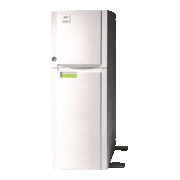Fujitsu announced the FM-360SV series of PC servers in June 1994 as replacements for the FMR-340SV (introduced in July 1992) and the FMR-360SV (introduced in November 1993). What set this series apart from Fujitsu’s previous PC servers was the emphasis on scalability in consideration of greater support for applications such as database servers.
Features of the FM-360SV series:
- (1)Faster processing
- Fujitsu used fast Intel Pentium processors (66 MHz − 100 MHz) and introduced a dual CPU model. The maximum memory capacity was also increased to 384 MB.
- (2)Use of ECC memory
- Fujitsu used memory with ECC*1 technology as a means of improving reliability even with expanded memory capacity.
- (3)Support for disk arrays*2
- Fujitsu introduced disk array configurations to increase disk capacity.
- (4)Uninterruptable power-supply unit
- *1. ECC: Error checking and correction. A memory-error handling method capable of correcting one-bit memory errors and detecting two-bit errors.
*2. Disk arrays: Also known as RAID (redundant array of inexpensive disks). This methodology places multiple disks in parallel so they can be controlled as if one single disk both for greater disk capacity and for higher reliability.
| Model name | FM-360SV II 566E |
FM-360SV 466E |
FM-360SV 566E |
FM-360SV 599E |
|---|---|---|---|---|
| Introduced | June 1994 | |||
| CPU | Pentium (66MHz) |
486DX2 (66MHz) |
Pentium (66MHz) |
Pentium (100MHz) |
| No. of CPUs | 2 | 1 | ||
| Main memory | 32MB-384MB | 16MB-384MB | ||
| Internal disk (standard) | 1GB | |||
| Internal disk (expanded) | Selectable: 530 MB, 1 GB, 2 GB 7 slots | |||
| LAN card | Selectable(*1): 10BASE5/10BASE2 or 10BASE5/10BASE-T or 10BASE5/10BASE2 Token ring card(*2) | |||
| OS | Windows NT Windows NT AS(*3) |
Windows NT Windows NT AS(*3) OS/2 LAN Manager NetWare |
||
| その他 |
|
|||
(*1)10BASE: transmission speed of 10 Mbps.
(*2)Token ring: based on the IEEE 802.5 standard.
(*3)AS: Advanced server.
(*4)EISA: Extended Industry Standard Architecture.
(*2)Token ring: based on the IEEE 802.5 standard.
(*3)AS: Advanced server.
(*4)EISA: Extended Industry Standard Architecture.
The specifications above were correct at the time the products were announced. Some specifications were later revised due to product upgrades.


